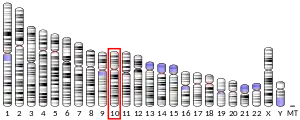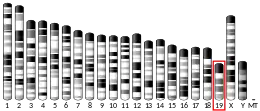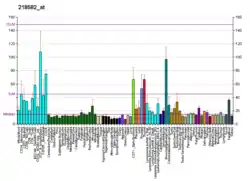| MARCHF5 | |||||||||||||||||||||||||||||||||||||||||||||||||||
|---|---|---|---|---|---|---|---|---|---|---|---|---|---|---|---|---|---|---|---|---|---|---|---|---|---|---|---|---|---|---|---|---|---|---|---|---|---|---|---|---|---|---|---|---|---|---|---|---|---|---|---|
| Identifiers | |||||||||||||||||||||||||||||||||||||||||||||||||||
| Aliases | MARCHF5, MARCH-V, MITOL, RNF153, membrane associated ring-CH-type finger 5, MARCH5 | ||||||||||||||||||||||||||||||||||||||||||||||||||
| External IDs | OMIM: 610637 MGI: 1915207 HomoloGene: 9862 GeneCards: MARCHF5 | ||||||||||||||||||||||||||||||||||||||||||||||||||
| |||||||||||||||||||||||||||||||||||||||||||||||||||
| |||||||||||||||||||||||||||||||||||||||||||||||||||
| |||||||||||||||||||||||||||||||||||||||||||||||||||
| |||||||||||||||||||||||||||||||||||||||||||||||||||
| |||||||||||||||||||||||||||||||||||||||||||||||||||
| Wikidata | |||||||||||||||||||||||||||||||||||||||||||||||||||
| |||||||||||||||||||||||||||||||||||||||||||||||||||
E3 ubiquitin-protein ligase MARCH5, also known as membrane-associated ring finger (C3HC4) 5, is an enzyme that, in humans, is encoded by the MARCH5 gene. It is localized in the mitochondrial outer membrane and has four transmembrane domains.[5][6][7]
Structure
Gene
The human gene MARCH5, also known as MITOL or RNF153, has 7 Exons and locates at the chromosome band 10q23.32-q23.33.[6]
Protein
The human E3 ubiquitin-protein ligase MARCH5 protein, a member of the transmembrane RING‐finger protein family[8] is 31 kDa in size and composed of 278 amino acids with a N-terminal Zinc-finger domain at amino acid sequence 6-75 and four C-terminal transmembrane spans.[7] The theoretical PI of this protein is 9.00.[9]
Function
As an E3 ubiquitin ligases, enzyme MARCH 5 catalyzes the transfer of ubiquitin from an E2 ubiquitin-conjugating enzyme to an identified protein substrate. MARCH5 was firstly identified as a mitofusin 2- and Drp1-binding protein.[7] MARCH5 promotes ubiquitination of Drp1 and a knockdown of MARCH5 is by RNAi led to abnormal mitochondrial fusion.[10] Further evidences show that MARCH 5 specifically interacts with mitofusin 1, by reducing the levels of it during certain phases of the cell cycle.[11] Given the facts that MARCH5 regulates the protein proteostasis of Drp1, mitofusin 1, and mitofusin 2 that are pivotal regulators of mitochondrial fusion and fission, MARCH5 is critical for the regulation of standard mitochondria morphology, and deficiencies in it promote cellular senescence.[12]
Clinical significance
Considering that both Drp1 and MAP1B are substrates for MITOL, MITOL is thought to play a protective role against nitrosative stress-mediated disruption of mitochondrial dynamics such as morphological stability and transport of mitochondria. As significantly decreased expression of MITOL occurs in response to ageing in normal tissues, MITOL may control ageing by regulating the production of ROS in mitochondria.[13] From a pathological perspective, in a neuronal cell model, dominant-negative MARCH5 prevents mitochondrial fragmentation during neurodegenerative stress induced by the neuron-specific reactive oxygen generator 6-hydroxydopamine, the complex I inhibitor rotenone or Alzheimer's-related amyloid beta peptide. MARCH5 is also involved in the removal of proteins associated with specific neurodegenerative disorders such as ataxin-3 in Machado–Joseph disease or mSOD1 in amyotrophic lateral sclerosis likely supporting mitochondrial function.[14] MARCH5 has also been linked to toll-like receptors (TLRs), which recognize distinct pathogen-associated molecular patterns and play a critical role in the innate immune response.[15]
Ubiquitin-dependent degradation pathways have clear cancer relevance due to their integral involvement in protein quality control, regulation of immune responses, signal transduction, and cell cycle regulation.[16]
Gene name error in Excel
Like the other MARCH and septin genes, care must be exercised when analyzing genetic data containing the MARCH5 gene in Microsoft Excel.[17] This is due to Excel's autocorrect feature treating the MARCH gene as a date and converting it to a standard date format. The original text cannot be recovered as a result of the conversion. A 2016 study found up to 19.6% of all papers in selected journals to be affected by the gene name error.[18] The issue can be prevented by using an alias name such as MARCHF5, prepending with an apostrophe ('), or preformatting the cell as text.
References
- 1 2 3 GRCh38: Ensembl release 89: ENSG00000198060 - Ensembl, May 2017
- 1 2 3 GRCm38: Ensembl release 89: ENSMUSG00000023307 - Ensembl, May 2017
- ↑ "Human PubMed Reference:". National Center for Biotechnology Information, U.S. National Library of Medicine.
- ↑ "Mouse PubMed Reference:". National Center for Biotechnology Information, U.S. National Library of Medicine.
- ↑ Bartee E, Mansouri M, Hovey Nerenberg BT, Gouveia K, Früh K (Feb 2004). "Downregulation of major histocompatibility complex class I by human ubiquitin ligases related to viral immune evasion proteins". Journal of Virology. 78 (3): 1109–20. doi:10.1128/JVI.78.3.1109-1120.2004. PMC 321412. PMID 14722266.
- 1 2 "Entrez Gene: MARCH5 membrane-associated ring finger (C3HC4) 5".
- 1 2 3 Nakamura N, Kimura Y, Tokuda M, Honda S, Hirose S (Oct 2006). "MARCH-V is a novel mitofusin 2- and Drp1-binding protein able to change mitochondrial morphology". EMBO Reports. 7 (10): 1019–22. doi:10.1038/sj.embor.7400790. PMC 1618377. PMID 16936636.
- ↑ Lehner PJ, Hoer S, Dodd R, Duncan LM (Oct 2005). "Downregulation of cell surface receptors by the K3 family of viral and cellular ubiquitin E3 ligases". Immunological Reviews. 207: 112–25. doi:10.1111/j.0105-2896.2005.00314.x. PMID 16181331. S2CID 25567313.
- ↑ "Uniprot: Q9NX47 - MARH5_HUMAN".
- ↑ Yonashiro R, Ishido S, Kyo S, Fukuda T, Goto E, Matsuki Y, Ohmura-Hoshino M, Sada K, Hotta H, Yamamura H, Inatome R, Yanagi S (Aug 2006). "A novel mitochondrial ubiquitin ligase plays a critical role in mitochondrial dynamics". The EMBO Journal. 25 (15): 3618–26. doi:10.1038/sj.emboj.7601249. PMC 1538564. PMID 16874301.
- ↑ Park YY, Cho H (2012). "Mitofusin 1 is degraded at G2/M phase through ubiquitylation by MARCH5". Cell Division. 7 (1): 25. doi:10.1186/1747-1028-7-25. PMC 3542011. PMID 23253261.
- ↑ Park YY, Lee S, Karbowski M, Neutzner A, Youle RJ, Cho H (Feb 2010). "Loss of MARCH5 mitochondrial E3 ubiquitin ligase induces cellular senescence through dynamin-related protein 1 and mitofusin 1". Journal of Cell Science. 123 (Pt 4): 619–26. doi:10.1242/jcs.061481. PMC 2818198. PMID 20103533.
- ↑ Nagashima S, Tokuyama T, Yonashiro R, Inatome R, Yanagi S (May 2014). "Roles of mitochondrial ubiquitin ligase MITOL/MARCH5 in mitochondrial dynamics and diseases". Journal of Biochemistry. 155 (5): 273–9. doi:10.1093/jb/mvu016. PMID 24616159.
- ↑ Fang L, Li J, Flammer J, Neutzner A (2013). "MARCH5 inactivation supports mitochondrial function during neurodegenerative stress". Frontiers in Cellular Neuroscience. 7: 176. doi:10.3389/fncel.2013.00176. PMC 3794199. PMID 24133412.
- ↑ Shi HX, Liu X, Wang Q, Tang PP, Liu XY, Shan YF, Wang C (May 2011). "Mitochondrial ubiquitin ligase MARCH5 promotes TLR7 signaling by attenuating TANK action". PLOS Pathogens. 7 (5): e1002057. doi:10.1371/journal.ppat.1002057. PMC 3098239. PMID 21625535.
- ↑ Wang X, Herr RA, Hansen T (Dec 2008). "Viral and cellular MARCH ubiquitin ligases and cancer". Seminars in Cancer Biology. 18 (6): 441–50. doi:10.1016/j.semcancer.2008.09.002. PMC 2636702. PMID 18948196.
- ↑ Zeeberg BR, Riss J, Kane DW, Bussey KJ, Uchio E, Linehan WM, et al. (June 2004). "Mistaken identifiers: gene name errors can be introduced inadvertently when using Excel in bioinformatics". BMC Bioinformatics. 5 (1): 80. doi:10.1186/1471-2105-5-80. PMC 459209. PMID 15214961.
- ↑ Ziemann M, Eren Y, El-Osta A (August 2016). "Gene name errors are widespread in the scientific literature". Genome Biology. 17 (1): 177. doi:10.1186/s13059-016-1044-7. PMC 4994289. PMID 27552985.
Further reading
- Karbowski M, Neutzner A, Youle RJ (Jul 2007). "The mitochondrial E3 ubiquitin ligase MARCH5 is required for Drp1 dependent mitochondrial division". The Journal of Cell Biology. 178 (1): 71–84. doi:10.1083/jcb.200611064. PMC 2064424. PMID 17606867.
- Nakamura N, Kimura Y, Tokuda M, Honda S, Hirose S (Oct 2006). "MARCH-V is a novel mitofusin 2- and Drp1-binding protein able to change mitochondrial morphology". EMBO Reports. 7 (10): 1019–22. doi:10.1038/sj.embor.7400790. PMC 1618377. PMID 16936636.
- Yonashiro R, Ishido S, Kyo S, Fukuda T, Goto E, Matsuki Y, Ohmura-Hoshino M, Sada K, Hotta H, Yamamura H, Inatome R, Yanagi S (Aug 2006). "A novel mitochondrial ubiquitin ligase plays a critical role in mitochondrial dynamics". The EMBO Journal. 25 (15): 3618–26. doi:10.1038/sj.emboj.7601249. PMC 1538564. PMID 16874301.
- Subramanian A, Andronache A, Li YC, Wade M (Feb 2016). "Inhibition of MARCH5 ubiquitin ligase abrogates MCL1-dependent resistance to BH3 mimetics via NOXA". Oncotarget. 7 (13): 15986–6002. doi:10.18632/oncotarget.7558. PMC 4941292. PMID 26910119.




